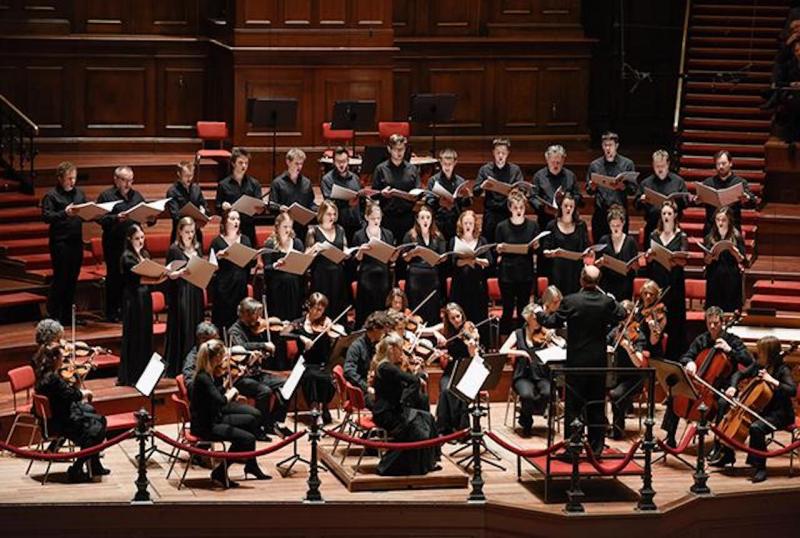St John Passion, Polyphony, OAE, Layton, St John's Smith Square review - defiant performance reveals Bach masterpiece anew | reviews, news & interviews
St John Passion, Polyphony, OAE, Layton, St John's Smith Square review - defiant performance reveals Bach masterpiece anew
St John Passion, Polyphony, OAE, Layton, St John's Smith Square review - defiant performance reveals Bach masterpiece anew
Every opportunity taken to point up the jagged emotions in the text and music

The turbulence and agitation of betrayal could be felt from the word go in this galvanising performance of the St John Passion, which administered a jolting urgency to Bach’s radical portrayal of the Easter story. The work will be 300 years old next year, yet this Polyphony Good Friday performance – a fixture at St John’s Smith Square for slightly fewer years – delivered a version as fresh and discomfiting as if the crucifixion had taken place yesterday.
That was in no small part due to Nick Pritchard (pictured below), who as the Evangelist narrated the story with a vibrancy that suggested he was discovering the facts as he sang them. Pritchard has performed the role internationally in both the Matthew and John Passions and his experience shows; watching his face and listening to the nuance in his voice was like watching a CNN report with infinitely better music.
Stephen Layton conducted both Polyphony and the Orchestra of the Age of Enlightenment for this stirring afternoon, in which the opening movement sounded like a brewing storm. At first it sounded remote and a little ragged, but then the first “Herr” came in with the force of a bolt of lightning, and the electricity started to manifest itself.
The St John Passion is famously a mash-up of texts, combining the Lutheran translation of chapters 18 and 19 from St John’s Gospel with a few fragments from St Matthew’s Gospel, a smattering of Psalm 8 and a drizzle of Passion poetry. It’s interesting, then, to interrogate precisely what Bach wanted to highlight in his first lengthy rendition of the Easter story. Perhaps it’s not surprising – given how fractious his own professional life was – that the focus is so strongly on the treachery and unreliability of those surrounding Christ.
 Layton missed no opportunity to point up the jagged emotions in the text and music, whether it was through Beethoven-worthy shifts from piano to sforzando in the dynamics or in the sinister emphasis of the consonants. In that first chorus, we heard the growing hiss as the choir members leant on the double “s” – or the “eszett” – “grössten". Much later, when the crowd protested that they had no king but Caesar, the “k”s cut the air, “Wir haben keinen König denn den Kaiser”.
Layton missed no opportunity to point up the jagged emotions in the text and music, whether it was through Beethoven-worthy shifts from piano to sforzando in the dynamics or in the sinister emphasis of the consonants. In that first chorus, we heard the growing hiss as the choir members leant on the double “s” – or the “eszett” – “grössten". Much later, when the crowd protested that they had no king but Caesar, the “k”s cut the air, “Wir haben keinen König denn den Kaiser”.
The agitation also came across in the phrasing: when mezzo-soprano Helen Charlston delivered her fine and intelligent rendition of "Von den Stricken meiner Sünden", the orchestral accompaniment was defiantly detached. Throughout, the pauses between the words often felt as important as the words themselves. In the chorus "Who was it, Lord, did smite thee?" ("Wer hat dich so geschlagen?"), there were exaggerated gaps between every image, right down to the dramatic rallentando in the last line about “the host of torments that thou bore”. As well as bringing greater clarity to the lyrics this roughened up the texture, ensuring that despite the familiarity of the story our ears were never dulled to the message it conveyed.
Bass-baritone James Rutherford was an imposing Jesus; almost too formidable in some ways, it was difficult to imagine how anyone had dared to confront him. Though he was wonderfully matched by Ashley Riches’ anguished Pilate, so compellingly distraught when the crowd chose to release Barrabas instead of Jesus, that for a moment you wondered if he was even going to let the crucifixion happen.
There were some instances where the performances didn’t altogether match the power of the text and the music. At a couple of points, split-second tuning wobbles distracted from the dramatic tension. At a different point Ruairi Bowen’s tenor, though undeniably fine, didn’t soar to the emotional heights suggested by the lyrics “Erwäge, wie sein blutgefärbte Rucken/in allen Stücken dem Himmel gliche geht!” (“Imagine, that his blood-bespattered body/in every member is part of Heaven above”).
For this is, as certain critics have pointed out, not just about the drama and the turbulence, but also about the cosmic Christ, who dies and rises again, bringing with him the vision of eternal life. This interpretation was fantastic for its spiky dissection of the work’s most difficult emotions. Yet it’s important too to evoke its more transcendent aspects, from the heavenly to the apocalyptic.
Once more it was Pritchard who effortlessly embraced this range; not least in his description of how the earth quaked (“die Erde erbebete”) after Christ’s death. Riches too rose to the occasion in his marvelling interrogation of whether, now Christ was dead, he himself was eternally free from death, “bin ich vom Sterben frei gemacht?”
Now that the drama was over, Layton allowed the phrasing to flow more lyrically in the chorus, “Rest well, beloved, sweetly sleeping” (“Ruht wohl, ihr heiligen Gebeine”). Then, for the exquisite final Chorale we were back to a deliberate, textured progression, which was eventually eclipsed by a luminous crescendo that signalled both the end and the ascent to Heaven.
rating
Explore topics
Share this article
The future of Arts Journalism
You can stop theartsdesk.com closing!
We urgently need financing to survive. Our fundraising drive has thus far raised £49,000 but we need to reach £100,000 or we will be forced to close. Please contribute here: https://gofund.me/c3f6033d
And if you can forward this information to anyone who might assist, we’d be grateful.

Subscribe to theartsdesk.com
Thank you for continuing to read our work on theartsdesk.com. For unlimited access to every article in its entirety, including our archive of more than 15,000 pieces, we're asking for £5 per month or £40 per year. We feel it's a very good deal, and hope you do too.
To take a subscription now simply click here.
And if you're looking for that extra gift for a friend or family member, why not treat them to a theartsdesk.com gift subscription?
more Classical music
 Anja Mittermüller, Richard Fu, Wigmore Hall review - a glorious hall debut
The Austrian mezzo shines - at the age of 22
Anja Mittermüller, Richard Fu, Wigmore Hall review - a glorious hall debut
The Austrian mezzo shines - at the age of 22
 First Person: clarinettist Oliver Pashley on the new horizons of The Hermes Experiment's latest album
Compositions by members of this unusual quartet feature for the first time
First Person: clarinettist Oliver Pashley on the new horizons of The Hermes Experiment's latest album
Compositions by members of this unusual quartet feature for the first time
 Gesualdo Passione, Les Arts Florissants, Amala Dior Company, Barbican review - inspired collaboration excavates the music's humanity
At times it was like watching an anarchic religious procession
Gesualdo Passione, Les Arts Florissants, Amala Dior Company, Barbican review - inspired collaboration excavates the music's humanity
At times it was like watching an anarchic religious procession
 Classical CDs: Camels, concrete and cabaret
An influential American composer's 90th birthday box, plus British piano concertos and a father-and-son duo
Classical CDs: Camels, concrete and cabaret
An influential American composer's 90th birthday box, plus British piano concertos and a father-and-son duo
 Cockerham, Manchester Camerata, Sheen, Martin Harris Centre, Manchester review - re-enacting the dawn of modernism
Two UK premieres added to three miniatures from a seminal event of January 1914
Cockerham, Manchester Camerata, Sheen, Martin Harris Centre, Manchester review - re-enacting the dawn of modernism
Two UK premieres added to three miniatures from a seminal event of January 1914
 Kempf, Brno Philharmonic, Davies, Bridgewater Hall, Manchester review - European tradition meets American jazz
Bouncing Czechs enjoy their Gershwin and Brubeck alongside Janáček and Dvořák
Kempf, Brno Philharmonic, Davies, Bridgewater Hall, Manchester review - European tradition meets American jazz
Bouncing Czechs enjoy their Gershwin and Brubeck alongside Janáček and Dvořák
 Solomon, OAE, Butt, QEH review - daft Biblical whitewashing with great choruses
Even a top soprano and mezzo can’t make this Handel paean wholly convincing
Solomon, OAE, Butt, QEH review - daft Biblical whitewashing with great choruses
Even a top soprano and mezzo can’t make this Handel paean wholly convincing
 Two-Piano Gala, Kings Place review - shining constellations
London Piano Festival curators and illustrious friends entertain and enlighten
Two-Piano Gala, Kings Place review - shining constellations
London Piano Festival curators and illustrious friends entertain and enlighten
 Echo Vocal Ensemble, Latto, Union Chapel review - eclectic choral programme garlanded with dance
Beautiful singing at the heart of an imaginative and stylistically varied concert
Echo Vocal Ensemble, Latto, Union Chapel review - eclectic choral programme garlanded with dance
Beautiful singing at the heart of an imaginative and stylistically varied concert
 Scott, Irish Baroque Orchestra, Whelan, RIAM, Dublin review - towards a Mozart masterpiece
Characteristic joy and enlightenment from this team, but a valveless horn brings problems
Scott, Irish Baroque Orchestra, Whelan, RIAM, Dublin review - towards a Mozart masterpiece
Characteristic joy and enlightenment from this team, but a valveless horn brings problems
 Classical CDs: Voice flutes, flugelhorns and froth
Baroque sonatas, English orchestral music and an emotionally-charged vocal recital
Classical CDs: Voice flutes, flugelhorns and froth
Baroque sonatas, English orchestral music and an emotionally-charged vocal recital

Add comment